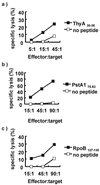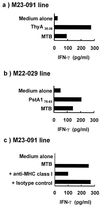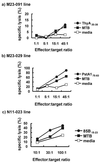Antimicrobial activity of MHC class I-restricted CD8+ T cells in human tuberculosis
- PMID: 11035787
- PMCID: PMC17320
- DOI: 10.1073/pnas.210391497
Antimicrobial activity of MHC class I-restricted CD8+ T cells in human tuberculosis
Abstract
Studies of mouse models of tuberculosis (TB) infection have indicated a central role for MHC class I-restricted CD8+ T cells in protective immunity. To define antigens and epitopes of Mycobacterium tuberculosis (MTB) proteins that are presented by infected cells to CD8+ T cells, we screened 40 MTB proteins for HLA class I A*0201-binding motifs. Peptides that bound with high affinity to purified HLA molecules were subsequently analyzed for recognition by CD8+ cytotoxic T lymphocytes. We identified three epitopes recognized by CD8+ T cells from patients recovering from TB infection. Those three epitopes were derived from three different antigens: thymidylate synthase (ThyA(30-38)), RNA polymerase beta-subunit (RpoB(127-135)), and a putative phosphate transport system permease protein A-1 (PstA1(75-83)). In addition, CD8+ T cell lines specific for three peptides (ThyA(30-38), PstA1(75-83), and 85B(15-23)) were generated from peripheral blood mononuclear cells of normal HLA-A*0201 donors. These CD8+ T cell lines specifically recognized MTB-infected macrophages, as demonstrated by production of IFN-gamma and lysis of the infected target cells. Finally, CD8+ cytotoxic T lymphocytes reduced the viability of the intracellular MTB, providing evidence that CD8+ T cell recognition of MHC class I-restricted epitopes of these MTB antigens can contribute to effective immunity against the pathogen.
Figures





References
Publication types
MeSH terms
Substances
Grants and funding
LinkOut - more resources
Full Text Sources
Other Literature Sources
Medical
Molecular Biology Databases
Research Materials

